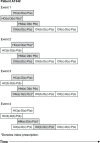Doctor Shopping Behavior and the Diversion of Prescription Opioids
- PMID: 28469426
- PMCID: PMC5398712
- DOI: 10.1177/1178221817696077
Doctor Shopping Behavior and the Diversion of Prescription Opioids
Erratum in
-
Erratum.Subst Abuse. 2018 Apr 11;11:1178221817724034. doi: 10.1177/1178221817724034. eCollection 2017. Subst Abuse. 2018. PMID: 35173436 Free PMC article.
Abstract
Objectives: "Doctor shopping" as a means of prescription opioid diversion is examined. The number and percentage of prescriptions and morphine-equivalent milligrams diverted in this manner are estimated by state and molecule for the period 2008-2012.
Methods: Eleven billion prescriptions with unique patient, doctor, and pharmacy identifiers were used to construct diversion "events" that involved between 1 and 6 unique doctors and between 1 and 6 unique pharmacies. Diversion thresholds were established based on the probability of each contingency.
Results: A geographically widespread decline occurred between 2008 and 2012. The number of prescriptions diverted fell from approximately 4.30 million (1.75% of all prescriptions) in 2008 to approximately 3.37 million (1.27% of all prescriptions) in 2012, and the number of morphine-equivalent milligrams fell from approximately 6.55 metric tons (2.95% of total metric tons) in 2008 to approximately 4.87 metric tons (2.19% of total metric tons) in 2012.
Conclusions: Diversion control efforts have likely been effective. But given increases in opioid-related deaths, opioid-related drug treatment admissions, and the more specific resurgence of heroin-related events, it is clear that additional public health measures are required.
Keywords: Doctor shopping; prescription diversion; prescription opioid diversion; prescription opioids.
Conflict of interest statement
DECLARATION OF CONFLICTING INTERESTS: The author(s) declared no potential conflicts of interest with respect to the research, authorship, and/or publication of this article.
Figures
References
-
- Substance Abuse and Mental Health Services Administration. Results from the 2012 National Survey on Drug Use and Health: Summary of National Findings (Detailed Tables). Rockville, MD: Department of Health and Human Services; 2015. HHS Publication No. (SMA) 13-4795, NSDUH Series H-46.
-
- Substance Abuse and Mental Health Services Administration Behavioral Health Trends in the United States: Results from the 2014 National Survey on Drug Use and Health. Rockville, MD: Department of Health and Human Services; 2015. HHS Publication No. (SMA) 15-4927, NSDUH Series H-50.
-
- Substance Abuse and Mental Health Services Administration. Drug Abuse Warning Network, 2011: National Estimates of Drug-Related Emergency Department Visits. Rockville, MD: Department of Health and Human Services; 2013. HHS Publication No. (SMA) 13-4760, DAWN Series D-39.
-
- Substance Abuse and Mental Health Services Administration. Treatment Episode Data Set—Admissions (TEDS-A)—Concatenated, 1992 to 2012. Ann Arbor, MI: Inter-University Consortium for Political and Social Research; 2015. ICPSR 25221.
-
- Substance Abuse and Mental Health Services Administration. National Admissions to Substance Abuse Treatment Services. Rockville, MD: Department of Health and Human Services; 2015. HHS Publication No. (SMA) XX-XXXX, BHSIS Series X-XX.
Publication types
LinkOut - more resources
Full Text Sources
Other Literature Sources




